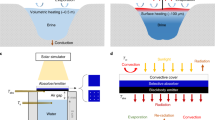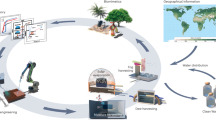Abstract
Monolayer products can potentially provide a cost effective solution for reducing evaporative loss from water storages. Commercial adoption has been low, due to the extreme variability of product performance. In this study, the efficiency of three monolayer compounds (stearyl alcohol, ethylene glycol monooctadecyl ether and the commercial product WaterSavr) in reducing evaporation were tested at three controlled wind speeds inside a glasshouse in class-A evaporation pans. Water levels and micrometeorological conditions were monitored to document the impact of prevailing atmospheric conditions on monolayer performance. The evaporation reduction ranged from 13 to 71 % depending on the product and micrometeorological conditions. The ethylene glycol monooctadecyl ether was most effective reducing evaporation across all wind speeds. Atmospheric conditions markedly affected monolayer products’ performance. All monolayers were most effective when the wind was sufficient to drive evaporative loss but lacked the force to disrupt the condensed monolayer (1.5 m s−1). Continuous wind of 3 m s−1 disrupted the condensed monolayer and substantially decreased the product performance. Without wind, the resistance to evaporation induced by monolayers had little additional effect. When atmospheric evaporation demand was very low, the evaporation suppression efficiency was minimized. High temperatures and high incoming radiation negatively affected the persistence of the condensed monolayer and decreased product performance. These results highlight the importance of analysing micrometeorological conditions when assessing product performance.









Similar content being viewed by others
References
Barnes GT (2008) The potential for monolayers to reduce the evaporation of water from large water storages. Agric Water Manag 95(4):339–353. doi:10.1016/j.agwat.2007.12.003
Bower SM, Saylor JR (2011) The effects of surfactant monolayers on free surface natural convection. Int J Heat Mass Transfer 54(25–26):5348–5358. doi:10.1016/j.ijheatmasstransfer.2011.08.008
Brink GN (2011) Universal design framework for optimal application of chemical monolayer to open water surfaces. Dissertation, University of Southern Queensland
Brooks JH, Alexander AE (1960) Losses by evaporation and solution from monolayers of long-chain aliphatic alcohols. Proceedings of the Third International Congress of Surface Activity, vol. IV, Cologne, Germany: 196–201
Carter R, Kay M, Weatherhead K (1999) Water losses in smallholder irrigation schemes. Agric Water Manag 40(1):15–24. doi:10.1016/s0378-3774(98)00098-5
Coop PA, Lamb DW, Fellows CM, Bradbury R (2011) Automatic detection of evaporation reducing monolayers. Proceedings of the Biennial Conference of the Australian Society for Engineering in Agriculture Surfers Paradise, Queensland, Australia, 29–30 September 2011: 159–168
Craig I, Green A, Scobie M, Schmidt E (2005) Controlling evaporation loss from water storages. NCEA Publication No. 1000580/1, Queensland, Australia
Crow FR, Mitchell AL (1975) Wind effects on chemical films for evaporation suppression at lake Hefner. Water Resour Res 11:493–495
Daigo K, Phaovattana V (1999) Evaporation and percolation control in small farm ponds in Thailand. Jarq-Jpn Agr Res Q 33(1):47–56
de Fraiture C, Wichelns D (2010) Satisfying future water demands for agriculture. Agric Water Manag 97(4):502–511. doi:10.1016/j.agwat.2009.08.008
Deo AV, Kulkarni SB, Gharpurey MK, Biswas AB (1962) Rate of spreading and equilibrium spreading pressure of the monolayers of n-fatty alcohols and n-alkoxy ethanols. J Phys Chem 66:1361–1362
Eames IW, Marr NJ, Sabir H (1997) The evaporation coefficient of water: a review. Int J Heat Mass Transfer 40(12):2963–2973. doi:10.1016/s0017-9310(96)00339-0
Fietz TR (1959) Water-loss investigations: Lake Hefner. Evaporation reduction investigations, report of the collaborators, Technical report, U.S. Bureau of Reclamation, Washington DC, United States
Fitzgerald LM, Vines RG (1963) Retardation of evaporation by monolayers: practical aspects of the treatment of large water storages. Aust J Appl Sci 14:340–346
Frenkiel J (1965) Evaporation reduction: physical and chemical principles and review of experiments. UNESCO, Paris
Gladyshev M (2002) Biophysics of the surface microlayer of aquatic ecosystems. IWA Publishing, London
Gokbulak F, Ozhan S (2006) Water loss through evaporation from water surfaces of lakes and reservoirs in Turkey. Official Publication of the European Water Association, EWA
Hancock N, Pittaway P, Symes T (2009) Towards a biophysical understanding of observed performance of evaporation suppressant films applied to agricultural water storages–first analyses. Agricultural Technologies in a Changing Climate, Brisbane, Australia, 13–16 Sep 2009
Harbeck GE, Koberg GE (1959) A method of evaluating the effect of a monomolecular film in suppressing reservoir evaporation. J Geophys Res 64(1):89–93
Hipsey MR, Sivapalan M (2003) Parameterizing the effect of a wind shelter on evaporation from small water bodies. Water Resour Res 39(12):1339. doi:10.1029/2002wr001784
Katsaros KB (1980) The aqueous thermal boundary layer. Bound-Layer Meteorol 18:107–127
Knights S (2005) Reducing evaporation with chemical monolayer technology. Aust Cotton Grow 26(3):32–33
Mansfield WW (1958) The influence of monolayers on evaporation from water storages 1. Aust J Appl Sci 9:245–254
Martinez Alvarez V, Gonzalez-Real MM, Baille A, Maestre Valero JF, Gallego Elvira B (2008) Regional assessment of evaporation from agricultural irrigation reservoirs in a semiarid climate. Agric Water Manag 95(9):1056–1066. doi:10.1016/j.agwat.2008.04.003
Martinez-Alvarez V, Maestre-Valero JF, Martin-Gorriz B, Gallego-Elvira B (2010) Experimental assessment of shade-cloth covers on agricultural reservoirs for irrigation in south-eastern Spain. Span J Agric Res 8:S122–S133
Martinez-Granados D, Francisco Maestre-Valero J, Calatrava J, Martinez-Alvarez V (2011) The economic impact of water evaporation losses from water reservoirs in the Segura Basin, SE Spain. Water Resour Manag 25(13):3153–3175. doi:10.1007/s11269-011-9850-x
McJannet D, Cook F, Hartcher M, Knight J, Burn S (2008) Evaporation reduction by monolayers: overview, modelling and effectiveness. Urban Water Security Research Alliance Technical Report No. 6
McMurry J (2004) Organic chemistry. Thomson Learning, Belmont
Mugabe FT, Hodnett MG, Senzanje A (2003) Opportunities for increasing productive water use from dam water: a case study from semi-arid Zimbabwe. Agric Water Manag 62(2):149–163. doi:10.1016/s0378-3774(03)00077-5
Oke TR (1987) Boundary layer climates. Methuen, London
Pittaway PA, van den Ancker TR (2010) Properties of natural microlayers on Australian freshwater storages and their potential to interact with artificial monolayers. Mar Freshw Res 61(10):1083–1091. doi:10.1071/mf09159
Reiser CO (1969) A system for controlling water evaporation. Ind Eng Chem Res 8:63–69
Segal L, Burstein L (2010) Retardation of water evaporation by a protective float. Water Resour Manag 24(1):129–137. doi:10.1007/s11269-009-9440-3
Shukla RN, Kulkarni SB (1962) The effect of wind speed on water evaporation reduction by the monolayers of alkoxy ethanols and n-alkyl alcohols. J Sci Ind Res India 21B:276–277
Timblin L, Florey Q, Garstka W (1962) Retardation of evaporation by monolayers: transport processes. Academic, New York and London
Wells AJ, Cenedese C, Farrar JT, Zappa CJ (2009) Variations in ocean surface temperature due to near-surface flow: straining the cool skin layer. J Phys Oceanogr 39(11):2685–2710. doi:10.1175/2009jpo3980.1
Acknowledgments
The authors acknowledge Foundation Seneca (Murcia, Spain, grant 15289/PI/10) and Foundation Ramon Areces (Madrid, Spain) for the financial support.
Author information
Authors and Affiliations
Corresponding author
Rights and permissions
About this article
Cite this article
Gallego-Elvira, B., Martínez-Alvarez, V., Pittaway, P. et al. Impact of Micrometeorological Conditions on the Efficiency of Artificial Monolayers in Reducing Evaporation. Water Resour Manage 27, 2251–2266 (2013). https://doi.org/10.1007/s11269-013-0286-3
Received:
Accepted:
Published:
Issue Date:
DOI: https://doi.org/10.1007/s11269-013-0286-3




